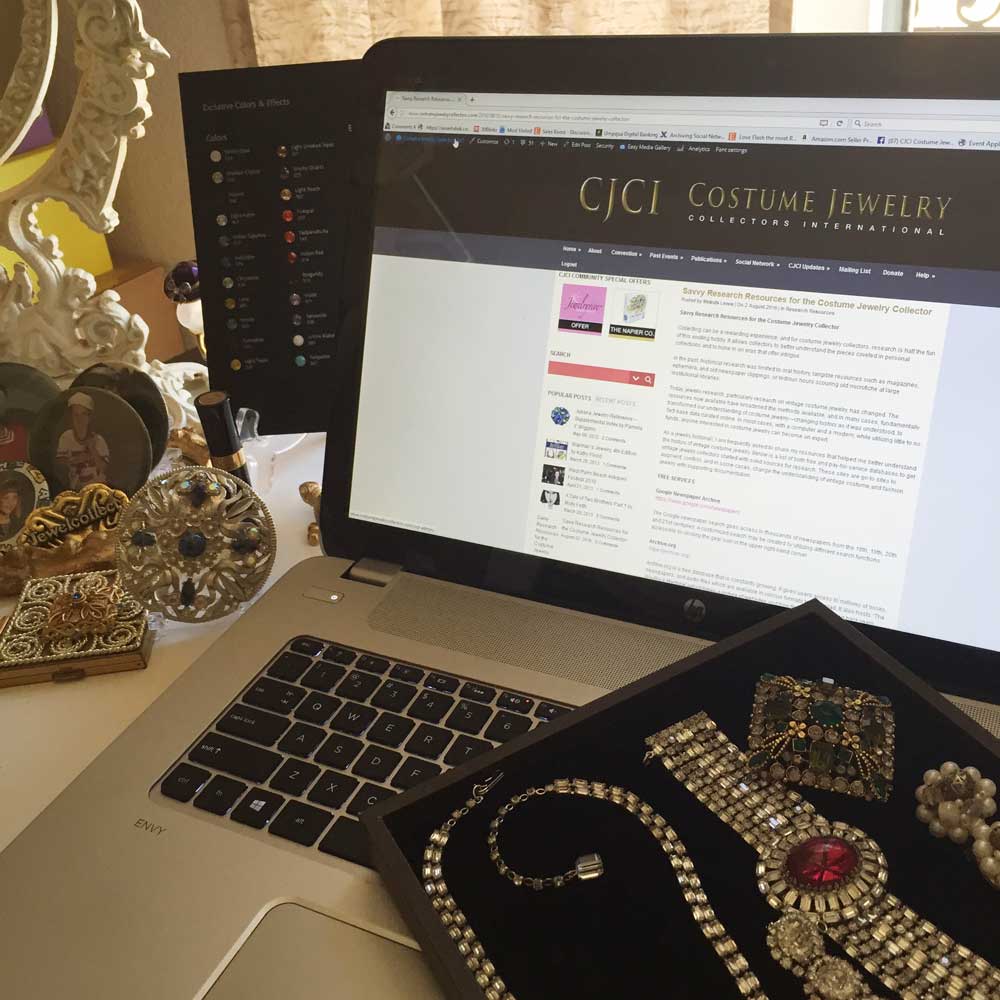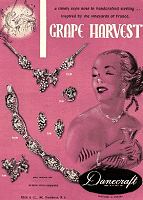
Speakers for CJCI Convention 2016
May 28, 2016
Identifying Stanley Hagler, Ian St. Gielar, and Mark Mercy Costume Jewelry Using Marks
August 22, 2016Savvy Research Resources for the Costume Jewelry Collector
Collecting can be a rewarding experience, and for costume jewelry collectors, research is half the fun of this exciting hobby. It allows collectors to better understand the pieces coveted in personal collections and to hone in on eras that offer intrigue.
In the past, historical research was limited to oral history, tangible resources such as magazines, ephemera, and old newspaper clippings, or tedious hours scouring old microfiche at large institutional libraries.

Today, jewelry research, particularly research on vintage costume jewelry, has changed. The resources now available have broadened the methods available, and in many cases, fundamentally transformed our understanding of costume jewelry—changing history as it was understood, to fact-base data curated online. In most cases, with a computer and a modem, while utilizing little to no funds, anyone interested in costume jewelry can become an expert.
As a jewelry historian, I am frequently asked to share my resources that helped me better understand the history of vintage costume jewelry. Below is a list of both free and pay-for-service databases to get vintage jewelry collectors started with solid sources for research. These sites are go-to sites to augment, confirm, and in some cases, change the understanding of vintage costume and fashion jewelry with supporting documentation.
FREE SERVICES
Google Newspaper Archive
https://news.google.com/newspapers
The Google newspaper search gives access to thousands of newspapers from the 18th, 19th, 20th and 21st centuries. A customized search may be created by utilizing different search functions accessible by clicking the gear icon in the upper right-hand corner.
Archive.org
https://archive.org/
Archive.org is a free database that is constantly growing. It gives users access to millions of books, newspapers, and audio files which are available in various formats to download. It also hosts “The WayBack Machine” which takes a picture of websites and how they appeared dating back years.
Note: not all websites are indexed here.
Google Books
https://books.google.com/
Google Books offers access to free downloadable books or snippets of books that can assist research. I found it particularly helpful with my patent and trademark research by downloading copies of the “Official Gazette of the United States Patent Office.”
Google Patents
https://patents.google.com/
The Google Patent site is not all inclusive. Many patents on the government site are not available on the Google Patent site, but it can be easier to locate some jewelry design patents. Search results can be obtained by either company name, designer, or specific design patent numbers.
The United State Trademark and Patent Office
http://www.uspto.gov/
The United States Trademark and Patent Office offers access to both patent and trademark history. It can be a cumbersome search, but by using the TESS system, one can locate trademark histories such as first used dates, filing dates and recording dates. Each stage of the process can offer information to our understanding of a particular company’s history. Design patents are also available in which researchers can download pdf or Tiff files.
Local Libraries
Local libraries often subscribe to databases for their customers or have book borrowing services from other libraries on the same network. Check with your local librarian to see what services are available at your library. Some of those subscriptions include, The New York Times, The Chicago Times, The Vogue Archive, Woman’s Wear Daily and Harper’s Bazaar among a few.
FEE-BASED SERVICES
The Newspaper Archives
http://www.newspaperarchive.com or the free version: http://newspaperarchive.com/free-newspaper-archives
This resource is a pay-for- service newspaper database that often has newspapers not included in the Google Newspaper site. For that reason, it is a substantial and inexpensive supplement to the free resources. Make sure you are receiving the least expensive monthly fee. Currently, it is $9.95 per month. It’s important to pay close attention to your renewal dates and the rates being offered at the time of renewal. SEE SECTION 4. Subscription Terms, Fees and Payments I find the site a little clunky from my experience, but sometimes the articles are well worth the added effort.
Ancestry.com
Ancestry.com offers access to passport information, census data, city directories, newspapers and “family trees” created by other patrons. This can be especially important when trying to ascertain employment or company commencement dates.
The Vogue Archives
https://login.voguearchive.com/LicenseStream/VogueLanding/VALandingDesktopP1.aspx
This archive is a fabulous resource to view decade by decade the fashions and jewelry history of the 19th, 20th and 21st century. It is expensive, now costing around $1500.00 per year opposed to over $3,000.00 when it first launched. The good news is some institutions and universities offer FREE access to this archive via Proquest through their library portal. It may take a bit of research to find an institution near you, but well worth the effort.
Note: Current subscribers to the magazine have access to the pass 12 months of Vogue, and limited access for article searches, advertisement, image, or garment searches. Unlike the fully paid membership, magazine subscribers are only allowed a limited capability to search by photographer, garment, industry, and brand.
Vintage Fashion and Advertisements–HPRINTS
http://www.hprints.com
This site is a terrific resource to purchase or peruse a huge archive of vintage fashion and jewelry advertisements. It is one of the lesser known sites on the internet. Be sure to show your appreciation for this wonderfully curated collection by purchasing an advertisement.
Next: How to Curate and File Jewelry History Data



